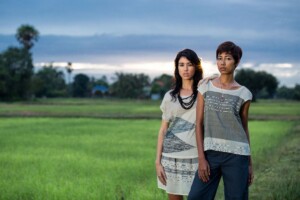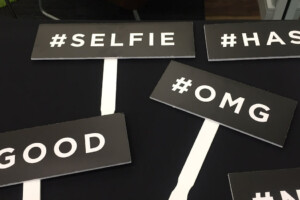
Think about how much clothing you buy in just one year. What about the clothing that you throw away?
This is just your personal consumption.
Now imagine an entire throw-away industry–that’s the fashion industry that Rachel Faller wants to change with her zero-waste fashion approach.
When she sat down to talk to us here at Change Creator, we thought we’d learn more about the staggering statistics of waste in the clothing industry, but it didn’t take long for us to learn so much more from this passionate social entrepreneur.

1 – Changing the Culture of Disposability
Our society is too quick to buy and throw things away. The clothing industry has an entire culture of quick and cheap or what insiders coin fast-fashion. For decades, this increased level of consumerism, matched with a wasteful industry, has led to devastating consequences for the environment, on the products, and on people’s lives, Faller would argue.
Nobody is coming up with sustainable fashion solutions to address the magnitude of this problem on a global scale, but thanks, in part to social entrepreneurs like her, things are beginning to shift.
How does Faller ensure consumers buy her brand, not just her mission?
In terms of fashion, she recognizes that the consumer is not going to stand behind your brand based on your mission or values alone; you must have a product that people are going to want to buy. Clothes have to look good, be at a price point that makes sense to consumers, and be accessible.
Faller’s approach to creating her zero-waste fashion is to address all of these industry concerns. She’s not just creating social change; she’s running a fashion business. We asked her what some of the challenges were in expanding her zero-waste fashion business, tonlé, and reaching more consumers, and she explained,
“The biggest challenge with ethical fashion today is that it’s just not as accessible.”
There are not enough ethical brands out there to meet the needs of consumers. “The way the industry is currently,” she says, “if you want to invest in ethical fashion, but have a party on Friday night, you probably won’t be able to find anything.”

Time is another factor that deters consumers from investing in ethical clothing as demands for new clothes increases each season with brands such as H&M, and Zara delivering. “What used to take the fashion industry 16 months to produce, from concept to clothing in the marketplace, now takes some brands one month,” Faller says. Consumers are demanding more options, lower prices, with little to no waiting times for the latest fashions, and the big brands are giving them what they want–at all costs.
“If we can get our clothes into those major retailers, then consumers are more likely to purchase our clothes. We don’t just need to get our clothes out there, we need consumers to demand ethical clothing, and we need to make clothes comparable in style and price” Faller argues.
There needs to be a demand for our clothing, but we also need to create that demand for ethical clothing through awareness or consumer protest. “Ultimately, people buy things because they like them. Once people come to our store or our website, if we don’t have merchandise that people will like, they won’t buy from us,” Faller explains.
2 – It’s Not Just About Awareness
An activist from a young age, Faller was exposed to world poverty issues early in life which implanted that inner motivation to make the world a better place.
“I knew what I wanted to contribute to in the world. In some way, these lessons from my travel stayed with me from a young age.”
However, not every volunteer opportunity is a good one. Looking back, it pains her to consider that some of these volunteer trips to help communities may actually have done more harm than good. Her advice: “Be mindful on how you try to change the world. It’s not just about travelling and volunteering abroad. Do your research before you decide to help other communities abroad.”
If you are taking away jobs from locals, for example, you are doing more harm than good in that community. “When vulnerable children, for example, are exposed to the revolving doors of help and volunteers, this can have damaging effects” Faller explains.
Being an agent for change means working within these communities, creating the right opportunities for people and that begins with education. Faller says it best:
“I know things can be different. I know it’s possible, especially if you immerse yourself in the communities that are doing all the work and collaborate with them.”
3 – Collaborating with Communities: A Change Creator Example: Dr. Gavin Armstrong
When Gavin decided to start marketing and selling his Lucky Iron Fish to help address the iron deficiencies in Cambodia, he knew he’d have to learn about the people in that country and work with them if his product was going to sell.
Some of these lessons came the hard way, as you can read about in Issue #6 of Change Creator Magazine. After so much research, working with community groups in Cambodia, Gavin thought he could simply travel around the country selling his Lucky Iron Fish, but this approach didn’t work. It wasn’t until he partnered with some local NGOs that already built trust and lines of communications with these communities that his sales began growing.
The lesson here: Work within–not just for–the communities you are serving. You are not going to solve a social problem and scale your business by creating a new social problem.
That level of trust needed to work within these communities does not happen overnight. Many so-called volunteer organizations do more harm than good. As Change Creators, we need to do our homework. Our solutions cannot tear apart a local economy, but rather, should work with them, building relationships to grow our companies.
4 – Outside of the Mainstream
Faller began to question her role in the fashion industry in college after a trip to Cambodia in 2007 exposed her to local artisan groups calling themselves fair-trade. She saw that there might be another way to pursue fashion and stay true to the core of her beliefs.
“I was hesitant to pursue a career in fashion because even at a young age, I didn’t want to participate in some of the practices in the industry,” she says. She studied textiles and fiber arts, but with more of a fine arts approach, by doing a lot of community artwork and working with a community art center.

Her passion for social justice did not go away, but neither did her love for making clothes. On her first trip to Cambodia, she learned about the fair-trade movement, especially as it related to textile and fashion.
She quickly got about to applying for the coveted Fulbright Scholarship so she could further study and learn from the fair-trade local artisan groups in Cambodia. It was not her intention at the time to start a clothing business, but as she grew to know the women in this local community and work with them to find suitable employment, it occurred to her: If not me, who?
Her intentions, at first, were to help a group of local women start their own ethical clothing company. But as this progressed, she quickly learned she could assist them more by giving them jobs and running the business herself. So, she did.
After returning from the yearlong year of research, she quickly moved on to starting her business. She was determined to take on two major issues: the wasteful clothing industry, and the lack of decent and safe opportunities for women in Cambodia.
5 – The Wasteful Clothing Industry
We asked Rachel about the environmental challenge she took on with her company, addressing the estimated 1 million tons of textile waste that dumped into landfills around the world each year, not to mention the factories that pollute 70% of China’s water.
As Faller says, “Garment factories waste a lot of fabric: minor imperfections, excess stock, and offcuts are all tossed out in the name of efficiency.”
This excessive waste is a major problem: That’s why tonlé has a zero-waste approach.
6 – Differentiating your brand: What makes Tonlé stand out?
Tonlé salvages scraps of material from offcuts that would otherwise be thrown away and repurposes them creatively to make new clothing: Say, a striped dress. They also use smaller scraps of material to make their own fabric yarn which is then weaved into bags, scarves, or even chunky jewellery.
Even after all this repurposing, there are still tiny scraps of fabric left which tonlé uses to create their own paper–leaving zero waste. This zero-waste approach is at the core of the brand, but it’s not Faller’s only focus.
Watch this video that details the process tonlé goes through to ensure zero waste in their clothing manufacturing:
7 – Giving Local Women Opportunities
Another key to Faller’s success and business model is providing a decent, safe working environment to local Cambodian women.
These women, who may have been working in unsafe situations as construction workers, factory workers, or simply unemployed would not have the livelihoods, fair, above-average pay and safe working conditions if it weren’t for tonlé.
Growing her business is not just about selling zero-waste clothing; it’s about changing the communities within Cambodia, one woman at a time.
As tonlé expands, so do opportunities, and that makes Rachel Faller a Change Creator to support.
Listen to our full interview with Rachel Faller
You might also want to check out these other articles…






